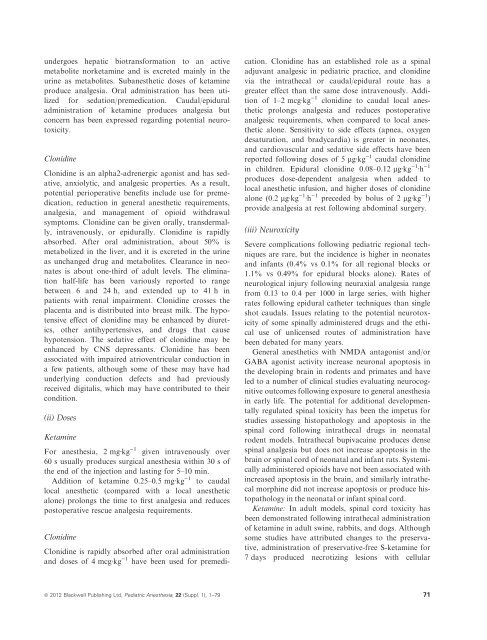Good Practice in Postoperative and Procedural Pain Management ...
Good Practice in Postoperative and Procedural Pain Management ...
Good Practice in Postoperative and Procedural Pain Management ...
Create successful ePaper yourself
Turn your PDF publications into a flip-book with our unique Google optimized e-Paper software.
undergoes hepatic biotransformation to an activemetabolite norketam<strong>in</strong>e <strong>and</strong> is excreted ma<strong>in</strong>ly <strong>in</strong> theur<strong>in</strong>e as metabolites. Subanesthetic doses of ketam<strong>in</strong>eproduce analgesia. Oral adm<strong>in</strong>istration has been utilizedfor sedation/premedication. Caudal/epiduraladm<strong>in</strong>istration of ketam<strong>in</strong>e produces analgesia butconcern has been expressed regard<strong>in</strong>g potential neurotoxicity.Clonid<strong>in</strong>eClonid<strong>in</strong>e is an alpha2-adrenergic agonist <strong>and</strong> has sedative,anxiolytic, <strong>and</strong> analgesic properties. As a result,potential perioperative benefits <strong>in</strong>clude use for premedication,reduction <strong>in</strong> general anesthetic requirements,analgesia, <strong>and</strong> management of opioid withdrawalsymptoms. Clonid<strong>in</strong>e can be given orally, transdermally,<strong>in</strong>travenously, or epidurally. Clonid<strong>in</strong>e is rapidlyabsorbed. After oral adm<strong>in</strong>istration, about 50% ismetabolized <strong>in</strong> the liver, <strong>and</strong> it is excreted <strong>in</strong> the ur<strong>in</strong>eas unchanged drug <strong>and</strong> metabolites. Clearance <strong>in</strong> neonatesis about one-third of adult levels. The elim<strong>in</strong>ationhalf-life has been variously reported to rangebetween 6 <strong>and</strong> 24 h, <strong>and</strong> extended up to 41 h <strong>in</strong>patients with renal impairment. Clonid<strong>in</strong>e crosses theplacenta <strong>and</strong> is distributed <strong>in</strong>to breast milk. The hypotensiveeffect of clonid<strong>in</strong>e may be enhanced by diuretics,other antihypertensives, <strong>and</strong> drugs that causehypotension. The sedative effect of clonid<strong>in</strong>e may beenhanced by CNS depressants. Clonid<strong>in</strong>e has beenassociated with impaired atrioventricular conduction <strong>in</strong>a few patients, although some of these may have hadunderly<strong>in</strong>g conduction defects <strong>and</strong> had previouslyreceived digitalis, which may have contributed to theircondition.(ii) DosesKetam<strong>in</strong>eFor anesthesia, 2 mgÆkg )1 given <strong>in</strong>travenously over60 s usually produces surgical anesthesia with<strong>in</strong> 30 s ofthe end of the <strong>in</strong>jection <strong>and</strong> last<strong>in</strong>g for 5–10 m<strong>in</strong>.Addition of ketam<strong>in</strong>e 0.25–0.5 mgÆkg )1 to caudallocal anesthetic (compared with a local anestheticalone) prolongs the time to first analgesia <strong>and</strong> reducespostoperative rescue analgesia requirements.Clonid<strong>in</strong>eClonid<strong>in</strong>e is rapidly absorbed after oral adm<strong>in</strong>istration<strong>and</strong> doses of 4 mcgÆkg )1 have been used for premedication.Clonid<strong>in</strong>e has an established role as a sp<strong>in</strong>aladjuvant analgesic <strong>in</strong> pediatric practice, <strong>and</strong> clonid<strong>in</strong>evia the <strong>in</strong>trathecal or caudal/epidural route has agreater effect than the same dose <strong>in</strong>travenously. Additionof 1–2 mcgÆkg )1 clonid<strong>in</strong>e to caudal local anestheticprolongs analgesia <strong>and</strong> reduces postoperativeanalgesic requirements, when compared to local anestheticalone. Sensitivity to side effects (apnea, oxygendesaturation, <strong>and</strong> bradycardia) is greater <strong>in</strong> neonates,<strong>and</strong> cardiovascular <strong>and</strong> sedative side effects have beenreported follow<strong>in</strong>g doses of 5 lgÆkg )1 caudal clonid<strong>in</strong>e<strong>in</strong> children. Epidural clonid<strong>in</strong>e 0.08–0.12 lgÆkg )1 Æh )1produces dose-dependent analgesia when added tolocal anesthetic <strong>in</strong>fusion, <strong>and</strong> higher doses of clonid<strong>in</strong>ealone (0.2 lgÆkg )1 Æh )1 preceded by bolus of 2 lgÆkg )1 )provide analgesia at rest follow<strong>in</strong>g abdom<strong>in</strong>al surgery.(iii) NeuroxicitySevere complications follow<strong>in</strong>g pediatric regional techniquesare rare, but the <strong>in</strong>cidence is higher <strong>in</strong> neonates<strong>and</strong> <strong>in</strong>fants (0.4% vs 0.1% for all regional blocks or1.1% vs 0.49% for epidural blocks alone). Rates ofneurological <strong>in</strong>jury follow<strong>in</strong>g neuraxial analgesia rangefrom 0.13 to 0.4 per 1000 <strong>in</strong> large series, with higherrates follow<strong>in</strong>g epidural catheter techniques than s<strong>in</strong>gleshot caudals. Issues relat<strong>in</strong>g to the potential neurotoxicityof some sp<strong>in</strong>ally adm<strong>in</strong>istered drugs <strong>and</strong> the ethicaluse of unlicensed routes of adm<strong>in</strong>istration havebeen debated for many years.General anesthetics with NMDA antagonist <strong>and</strong>/orGABA agonist activity <strong>in</strong>crease neuronal apoptosis <strong>in</strong>the develop<strong>in</strong>g bra<strong>in</strong> <strong>in</strong> rodents <strong>and</strong> primates <strong>and</strong> haveled to a number of cl<strong>in</strong>ical studies evaluat<strong>in</strong>g neurocognitiveoutcomes follow<strong>in</strong>g exposure to general anesthesia<strong>in</strong> early life. The potential for additional developmentallyregulated sp<strong>in</strong>al toxicity has been the impetus forstudies assess<strong>in</strong>g histopathology <strong>and</strong> apoptosis <strong>in</strong> thesp<strong>in</strong>al cord follow<strong>in</strong>g <strong>in</strong>trathecal drugs <strong>in</strong> neonatalrodent models. Intrathecal bupivaca<strong>in</strong>e produces densesp<strong>in</strong>al analgesia but does not <strong>in</strong>crease apoptosis <strong>in</strong> thebra<strong>in</strong> or sp<strong>in</strong>al cord of neonatal <strong>and</strong> <strong>in</strong>fant rats. Systemicallyadm<strong>in</strong>istered opioids have not been associated with<strong>in</strong>creased apoptosis <strong>in</strong> the bra<strong>in</strong>, <strong>and</strong> similarly <strong>in</strong>trathecalmorph<strong>in</strong>e did not <strong>in</strong>crease apoptosis or produce histopathology<strong>in</strong> the neonatal or <strong>in</strong>fant sp<strong>in</strong>al cord.Ketam<strong>in</strong>e: In adult models, sp<strong>in</strong>al cord toxicity hasbeen demonstrated follow<strong>in</strong>g <strong>in</strong>trathecal adm<strong>in</strong>istrationof ketam<strong>in</strong>e <strong>in</strong> adult sw<strong>in</strong>e, rabbits, <strong>and</strong> dogs. Althoughsome studies have attributed changes to the preservative,adm<strong>in</strong>istration of preservative-free S-ketam<strong>in</strong>e for7 days produced necrotiz<strong>in</strong>g lesions with cellularª 2012 Blackwell Publish<strong>in</strong>g Ltd, Pediatric Anesthesia, 22 (Suppl. 1), 1–79 71
















